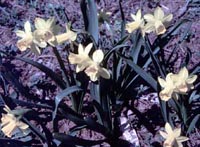Resource Library
Plant of the Week: Tete a Tete Daffodil
The University of Arkansas System Division of Agriculture does not promote, support or recommend plants featured in "Plant of the Week." Please consult your local Extension office for plants suitable for your region.
Plant of the Week
Tete a tete Daffodil
Latin: Narcissus 'Tete-a-Tete'

My favorite flower is in bloom, the little Tete-a-Tete daffodil. Of course, I should confess that being designated favorite is somewhat a passing fancy, for my head is easily turned by the next pretty face that passes by. But, among the thousands of daffodils on the market, this little gem is one of the best.
Tete-a-Tete is a little plant by daffodil standards, growing only about six inches tall with two or three rich gold blooms each 2 1/2 inches across atop the sturdy stem. The cup is about three-quarters of an inch long and the petals are slightly reflexed.
In most years, it is the first daffodil to bloom in my garden, appearing about the first of March. But this year, now that global warming seems to have firmly established a hold on our winters, all of my early and midseason daffodils are blooming at the same time.
Tete-a-Tete is what the daffodil society calls a Division 12 daffodil -- their catch-all miscellaneous class where all of the selections go that defy the arbitrary rules used to classify the 28,000 daffodil cultivars that have appeared over the past four centuries. Its foliage is only about eight inches long and very tidy. Tete-a-Tete is free branching and continues to produce lots of new bulbs each season and continues to flower freely year after year.
Being vertically challenged -- or as some would say, a runt -- it has developed two specialty uses. In the garden it is the premier choice for rock gardens or front-of-border locations where its diminutive stature is a benefit. Its second use is as a forced plant for sale in 4-inch pots. In fact, most gardeners are first introduced to this little plant as a forced bulb then later discover it does fabulously in the garden.
Is Tete-a-Tete a daffodil, a jonquil or a narcissus? To the botanist all of these plants are called by the genus name Narcissus which is made up of 25 Old World species which have been variously combined through breeding to give us the cultivars we grow today. If in doubt, call any of these plants "Narcissus" and you will never be wrong. The word itself is of ancient Greek extraction and shares the same root word as "narcotic" in reference to the fact that an extract of the bulbs could induce a drugged stupor.
The name "daffodil" in Old English was affodil which is derived from the Greek word asphodelos which, is a name for several bulbous flowers said to be the flower of the dead that cover the meadows of Hades. I must have missed Sunday school the day they discussed what kinds of flowers grew in the meadows of Hell! Generally, the name daffodil is assigned to flowers that have one bloom per stalk. No doubt the word was carried to England by the conquering Roman soldiers in the early years of the Christian era.
The name "jonquil" -- frequently used by Arkansas gardeners to describe daffodils -- is derived from the Latin word for a rush, which the foliage of N. jonquilla resembles.
Tete-a-Tete is easy to grow in full sun or part shade. It multiplies freely so should be divided every 5 to 10 years to prevent overcrowding of the bulbs. Like all bulbous plants, the bulbs should be planted in well drained soil. Allow the foliage to remain at least eight weeks after flowers fade to provide nourishment for next year’s blooms.
By: Gerald Klingaman, retired
Extension Horticulturist - Ornamentals
Extension News - March 3, 2000
The University of Arkansas System Division of Agriculture does not maintain lists of retail outlets where these plants can be purchased. Please check your local nursery or other retail outlets to ask about the availability of these plants for your growing area.